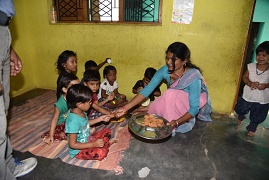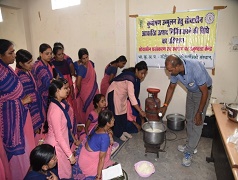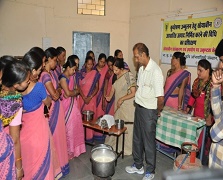According to NFHS-4 (National Family and Health Survey-2015-16), 38.4% of children under five years age are stunted (too short for their age) which indicates that, half of the country’s children are chronically malnourished. Nutritional deficiency is a major cause for concern in Madhya Pradesh as well. About 28.5% of women have chronic energy (nutritional) deficiency indicated by body mass index (BMI). According to the recent news, Hoshangabad district is one of the malnourished districts of M. P. with about 47% neonatal mortality rate followed by 17% post natal mortality rate (report of ICDS, Hoshangabad, 2016). About 15% children are suffering from severe malnutrition in the district.


To reduce the nutritional deficiency rate, Integrated Child Development Scheme (ICDS) is providing nutritious food through scheduled feeding programmes. In spite of these efforts, some children are in the stage of 3rd degree malnutrition. Such children are provided with special treatment and extra feeding of nutrition. Most of the children are suffering from grade-I and grade-II malnutrition.
In reference to above nutritional status, ICAR-CIAE (Central Institute of Agricultural Engineering), Bhopal is creating mass awareness regarding technology of locally produced soybean based food products through awareness camps, participating in seminars (specially organized for Atal Bal Palaks, officials of ICDS), organizing exhibitions, Nutrition Mela and training to the SHG (Self Help Group) members to enlighten and skill development to prepare soy foods, so that soy foods may enhance the nutritional status.
 After getting systematic training to prepare cost effective soy based food products, SHG members of different blocks are providing these nutritious products through Atal Bal Palaks to the malnourished Aanganwadi children to fulfill the nutrition requirement. After continuous supplementation of these soy products (20 g Soysattu, or 20 g soynuts or 25g soybiscuits/ day) for last 12 months, significant improvement was observed in the health of malnourished children.
After getting systematic training to prepare cost effective soy based food products, SHG members of different blocks are providing these nutritious products through Atal Bal Palaks to the malnourished Aanganwadi children to fulfill the nutrition requirement. After continuous supplementation of these soy products (20 g Soysattu, or 20 g soynuts or 25g soybiscuits/ day) for last 12 months, significant improvement was observed in the health of malnourished children.
Pipariya Block: There are 47 Aanganwadis which are adopted by 42 Atal Bal Palaks (social workers) of the Pipariya block. Collected data shows 620 malnourished children (grade –II) were present in the month of March 2017 before intervention of our programme. After creating awareness and supplementation of soy foods like soysattu, soynuts and soybiscuits regularly to these malnourished children, 46% (286) children gained weight during the intervention period. About 35.6% children who were in the category of Grade –II malnourishment, shifted to the grade- I malnutrition level, while 5.6% (35) children shifted to the normal category. About 23 (3.7%) children showed no change or reduction in weight and 55 (8.8%) children were not available to check their growth parameter as they left the place.
Itarsi Block: Total 66 Aanganwadis were adopted by 33 Atal Bal Palaks in Itarsi block. Before intervention of soy foods, 520 children were in the grade-II malnutrition status. After consumption of soy foods daily, 91% children gained weight and 5% shifted to normal category. While there were 168 children suffering from grade-III malnutrition, out of these, about 70% children gained weight, 2.3% shifted to normal category. Because of other health reasons, 28% children did not show any positive improvement.
Rural Hoshangbad Block: Before intervention of our programme, there 1206 grade –II malnourished and 100 severely malnourished children were in the block. After consumption of soy based food products, 77.6 % children gained weight and shifted to the grade-I malnutrition status. Out of 100 severely malnourished children, 16 children recovered, 8.5% shifted to grade –I malnutrition status, 1.32% shifted to normal category. There are 162 Aanganwadis in the block, adopted by 60 Atal Bal Palaks to improve the nutritional status of malnourished children.
The supplementation of soy based food improved the nutritional status of the beneficiaries. Further SHG members of the block preparing soy foods and selling to the Atal Bal Palaks, generated additional income and employment in the rural area.
(Source: ICAR-Central Institute of Agricultural Engineering, Bhopal)








Like on Facebook
Subscribe on Youtube
Follow on X X
Like on instagram